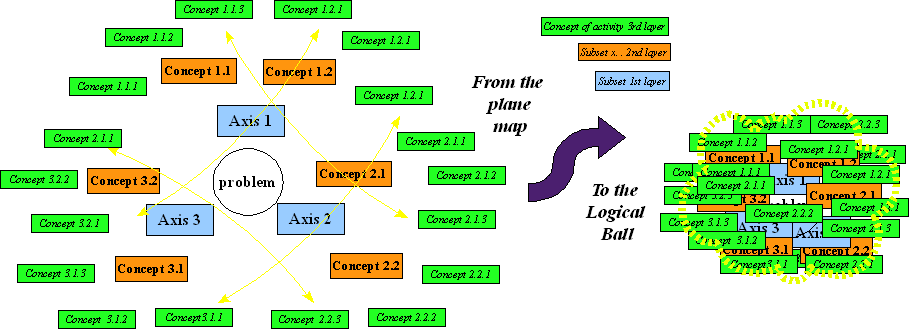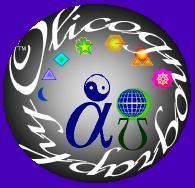Geometric Logic
In an intuitive way
Practical human reasoning is made of intuitions, imitations and knowledge. Collective knowledge is commonly undervalued, unarticulated, ignored or exagerated. Specialists or academics want to rule all that and often abuse, first on the scientificity of their science, making it poorly effective in pragmatic issues and often missing that most practice should be an art at the service of any people, not filtered by convenience. This means that proper managements of scientific knowledge should care how cultural issues proceed, exist and are often more opento essential changes, than thought.
This is to be managed together with revolution of information; methods and resources with and in social nearby environment. Potential local sources of information is commonly ignored especially for shaping analytic categories, while this is quite essential, since they often refer to operate categories. To think also that arts of scientific management can have derived too much toward the specialized will of rhetoretic and captured niches of dialectics (away from common utility)..
A pragmatic view, will seek to intermediate between the software of computers that can query in databases of essential knowledge, in limited time and not always well specified for applications within complexity of real world. Even when software programs are able to create virtual complexity, humans brains stay essential to conceive, study, picture and metadesign solutions. Solutions require concern, commitment and involvment in consistent environment but too our nature is lazzy, "unrationaly speculative", oversimplifying; whatever the level of wealth and even of achievment.
Olicognography sets perspectives on complex issues, while thinking that the right to reduce corresponds more to citizens, well commited with the need to adapt concepts to their local context; Not just hardly trying to understand what the perfect todays prophets distractors say. Indeed this comes together with the humanist hope that respecting human rights in their local specifications, practical forms can make good local democracies useful to communities. Common universal humane values may have (not bad) global tools; they must let enough to local specifications and definitions. Universal values could pretend to be the positive side of globalization; they cannot be vectored since so far. If so they are just obstructed by intermediate determinisms creating dellusions, biasing policies; making global village's civilisation a meltingpot of frustrations and illusions.
Pieces of Logic
Logic, language, solvable programs have collections of concepts, elements, sets and operations that , in our mind, can be logically managed as geometric pictures, enough for human social management: composing finite constructions, support modularity and reasonable freedom of inscription. Intuitive algebra of graph can apply to sets of arguments, operations and model pictured systems, for more complete approaches. Care to design your frames according practical issues and at close distance from consistent field. Pretending to be very practical with rude and very specified definitions, thousand of kilometers from real human theaters, whatever the telemeans you put, does not serve peace making constructions.
Byside of mathematic, what helps conceptual intermediation, would be friendly-to-users platforms. Also they can be helped by pictorial language close to users since the software of computers. That can be automated with democratically specified algebra of graph. Of course up to the system(s), to be enough robust (not to induced too specified mistakes) and intermediate steps preserve the rights of local democracies to define themselves while rigorous with knowledge inclusion.
Picturelly olicognography purpose is to help you build logical balls (for many), like for filling some practical logical complex space. Balls of the kind you will agree to play. Quite often their design proceeds since the center to out)or at the reverse from out to the center). Also to it is organized in layers. More operative frames will extended visually as flows. Supportive material extracted from litterature at best reshaped will complete more traditional frames.

Each layers of the logical ball will be composed, more or less directly with logical similar pieces, analogic branching. progressively more specific. Last very practical issues will stay up to you, and come after to redesigned or reshape or defined the logical frame you want. Logical pieces from "almost sure sciences" (which do not even pretend more to be perfect: say mathematics, logics, physics but are abused for this purpose by expert and reducers) are fundamental, but can be profanely suggestive (for their management like in logistics, economics, ecology).
Probably, because meaning something to cognitive process, logical pieces we use come also from "soft sciences". They are poorly practiced, more taken as convenient explanation often because the "leader" biased them toward its informal goals of its group of support specific when usefull to them, eluding evasive if they could serve others. We cannot make without ambiguity, contradictions and determinism. Examples of such "soft sciences" like when composing logical pieces as: structure-function-utility; social-technics-politics or social-economics-politics which will be useful in our abstract preliminary design, a bit better because mixed with other complex operators. What you have to mind, if what sort of logical small graph you would like to use, to stick the label of your series of concepts, on the nodes or at tops of your part of frame. Then, once the frame developed, mind that you managed with some cautions relevant to complex systems.
Consider complexity provides criteria, plasticity and needs for consensus. Not exactly as simple as graph algebra (which is commonly multiple linear matrix algebra), which could already be a positive step - compare to present management of social sciences. Web and graph analysis have slowly started, in a less rigid way as it was in general economy models. Social sciences already used inspiring series of terms, but mainly take them for what they would like: universal definitions of academic theorists; presenting more or less rigid specifications for execution in exclusive way of self promotion of their abstracts; assumed as reasons, causes and orders. Following them many stupid "subleaders" block any interpretation that would help otherwise practical implementations.
Indeed the number of concepts in each logical pieces part of a program, can vary a lot, but since it is to shape, structure, levels or scale, calculate solve and manage, their number (cardinal or ordinal) at near local level could between 2 to 5 in each layer; while structured from one layer to another with more or less explicit network properties. Overall see that you should stay with a manageable and calculable frame. Olicognograph logical ball has always at least one layer (the nucleus of a modulus) with generally more than 2 concepts for each layer-node and you often climb up or scale down when with more than 5 concepts.
Logical Ball as operating System
Since you understand that within complexities there are a primary difference between - real natural world complexity, calling for better wholistic incorporation - and - artificial human-made virtual complexity. Both not necesarilly match perfectly. You would understand that we do not object any need for reductions, but their feasability: where to set them, not oversize them, how to preserve enough "manageable" complexity. So as to care for more things and prepare in case of unexpected events.
To seek some unity to the logical ball system. You (re)design or adapt to your case; to cope with your problem. This logical ball defines like a logical model of your universe which can develop "openly within its reasonable creativity". Within because, in a limited world, what we can do, conceive, budget have limits; even if quite fuzzy and they could not be prejudged. After, the square of a circle you may use too the cube to represent the form of your ball. For example think that more formal concept are cube and more applied ones are spheric balls.
Be open, because expect that the universe of actors (making consistency, legitimity and density) can have economic extensions and relations; specify their contribution. You will seek to preserve some sense of economy with the logical ball, when minimal common shared model is accepted as the logical frame of reference. But do not use them only for prohibiting any different, especially if pragmatic contribution.
Whatever the degree of definition and specification, which is low, when far from the situation. There is nevertheless the idea that any real situation stays very complex; include facilities, resources and options that should care for other initiatives and programs. So there is always a huge trap in the rationality of a model. The gap of the distance should not be ignored by people preferring positive societies constructions. Objective rational trap should be cared and explored for innovations.
Also it is to mind that on the plane sheet of paper as a plane picture or in the screen as the display of a computer should mind 3 dimensions. To mimic better reality cognitive map should be seen as a volume, and in a dynamic way, so as any concept, more or less qualified as variable, parameter or operation relating variably to all other concepts, with some unity, while open to environment. Openess eventually summerized by the remain or residue of the model.
Everyone Should Gain from Interacting
Having discussed about the trap of the logical ball; it is to give sense and effect to it. We do no ask you to make a beautiful model, but to give effective sense in the way you cope (or want to cope) and dispose concepts for care of your reality. On one side because we think that this can give us clues to find you information and help to suggest calculations. On the other side these frames should reflect fields appropriations' and its adequacy to cases. These can be shared and organize feedbacks. Indeed it may sound ambitious and contradictory to our modest purpose and sense of respect of local democracy. But we should mind too that truncations do not address natural complexities. Neither that they should be just cared with tautological over- simplifications, centrally designed.
Human designers of communities' solution may give, eventually unconsciously, enough clues to help the interfaces and the system infere the fuzzy wish of users. Better if all the community (or working team) participate in that and expressed interactions they are willing to care. No one in assemblies should be shy or feel that it must, since the beginning delegates everything, especially at that step of design. Also for the intermediating program, ideograph or not, it is to detect what basic knowledge, in an economic way, would be the best; to help in the design of solutions of situations. Be helpful the system for communities (or working team) which have not necessarilly in mind all the knowledge needed.
A professionally well working team will check more easilly if what the system propose is consistent and which expertise is needed and how. Meanwhile, it will gain in managment and better explore social implementations of complex projects. Either communities (without plenty of experts) either designing team, it is to bridge the knowledge of naive practical expertise and include criteria, conditions and constraints for better sustain of complex project.
